For those of you who know and follow me, you know I love food preservation and often post about various methods and projects. In our house, we also cook primarily with whole, staple foods and try to eat as healthy as we can. Cheese and chocolate are our biggest weaknesses!
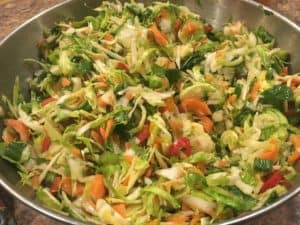 Why do I do it? Because we live in Minnesota and can’t have a garden year-round, it sure is cool to have green beans from our garden in January. I do it because my husband is a hunter and fisherman, and it’s really tasty to eat a grilled pheasant from the freezer in March, long after the season is over. And, I do it because I enjoy it.
Why do I do it? Because we live in Minnesota and can’t have a garden year-round, it sure is cool to have green beans from our garden in January. I do it because my husband is a hunter and fisherman, and it’s really tasty to eat a grilled pheasant from the freezer in March, long after the season is over. And, I do it because I enjoy it.
But, I realize that not everyone does this. Whether constrained by time, money, knowledge, interest, or whatever the case may be … not everyone preserves food, not everyone has a stocked pantry, and not everyone cooks. Not doing these things is FINE, but when we face times like we are currently facing, it may be a bit scary for you if you don’t.
So, today I wanted to share some simple tips to help you get a few things stocked in your home, and hopefully give you some peace of mind for the days to come.
Kitchen Staple Foods
 First of all, let’s talk staples for keeping in your pantry, refrigerator, and freezer. I’ve put together a quick list for you here.
First of all, let’s talk staples for keeping in your pantry, refrigerator, and freezer. I’ve put together a quick list for you here.
This is a VERY basic list, so take a peek at it as you think about your own family’s tastes and favorites, and add to it as needed.
But, if you only bought what is on this list, you would have what you need on hand to make several meals for your family.
Refrigerator Staples
- Milk
- Eggs
- Bread
- Butter
- Cheese
- Yogurt
- Fresh fruit and vegetables
- Condiments
Freezer Staples
- Ground hamburger
- Chicken breasts
- Other meat of choice
- Frozen fruit and vegetables
Pantry Staples
- Flour
- Sugar
- Spaghetti sauce
- Canned tomatoes
- Canned beans
- Other canned vegetables of choice
- Canned meat of choice
- Pasta and/or rice
- Onions, potatoes
- Salt, pepper, and other seasonings
Now, you may be looking at this list and wondering to yourself what you would make once you had these ingredients.
Here are a Few Quick Ideas
- Spaghetti and meatballs
- Beans and rice
- Chili
- Chicken noodle soup
- Grilled chicken salad
- Taco salad
- Meatloaf, mashed potatoes, and vegetables
- Chicken pot pie
- Tuna melts with vegetables
 Don’t be afraid to use your imagination. You can also look through a cookbook or two, or do some internet searches to find more ideas. There are lots of really delicious meals that can be made with not very many ingredients.
Don’t be afraid to use your imagination. You can also look through a cookbook or two, or do some internet searches to find more ideas. There are lots of really delicious meals that can be made with not very many ingredients.
Keep an eye on my Facebook page too! I will be announcing the next episode of my “What’s in Your Fridge” series soon, where we discuss ways to make meals with what you have available.
Staple Food Projects
As you may be finding more time on your hands during this time of social distancing and quarantines, there are some small projects you can do in the kitchen that are easy!
Freezer Jam
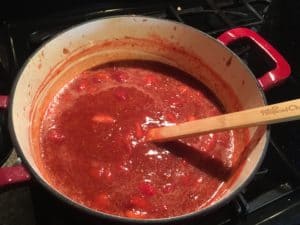 If you have some canned or frozen fruit you don’t know what to do with, it’s easy to make jam for the freezer (or refrigerator if you want to eat it within a week or so.) Jam is really just fruit and sugar that’s cooked down a bit to thicken. I make all of my jam low-sugar in a ratio of about 4 cups of fruit to 1 cup of sugar.
If you have some canned or frozen fruit you don’t know what to do with, it’s easy to make jam for the freezer (or refrigerator if you want to eat it within a week or so.) Jam is really just fruit and sugar that’s cooked down a bit to thicken. I make all of my jam low-sugar in a ratio of about 4 cups of fruit to 1 cup of sugar.
Many traditional jams have a lot more sugar than that in them. I cut sugar because we like it better that way and because sugar is just not very good for you.
So, you can adjust this per your family’s tastes, but I do encourage you to try it with less sugar first!
Basil Pesto
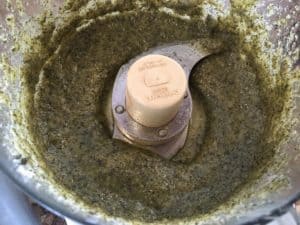 This is a fun thing to make at home too. It’s so easy! It’s usually made with fresh basil from the garden, but you can actually make it with dried basil. Other ingredients are olive oil, garlic, toasted nuts, Parmesan cheese, salt, and pepper.
This is a fun thing to make at home too. It’s so easy! It’s usually made with fresh basil from the garden, but you can actually make it with dried basil. Other ingredients are olive oil, garlic, toasted nuts, Parmesan cheese, salt, and pepper.
You just put everything in your food processor until it’s smooth. Pesto is great on toast with a pasta dinner, as the pasta sauce itself, on chicken, and more!
You can store your pesto in the fridge for a week or two, or it freezes well. It’s traditionally made with pine nuts but I usually use walnuts due to availability and cost. You can make this with other herbs, too.
Applesauce
Applesauce is another thing that’s really easy to make at home. I usually can mine, but you can make a small batch and eat it within a week or two and/or freeze some.
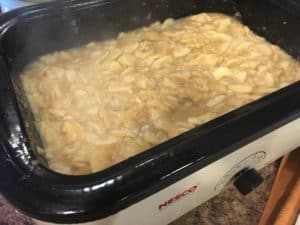 All you have to do is peel and slice your apples, soak them in a bit of lemon juice water to prevent browning, add sugar, and cook. This works great in an electric roaster or slow cooker on low. Just like my jam, I make mine with about half as much sugar as what is noted in most traditional recipes.
All you have to do is peel and slice your apples, soak them in a bit of lemon juice water to prevent browning, add sugar, and cook. This works great in an electric roaster or slow cooker on low. Just like my jam, I make mine with about half as much sugar as what is noted in most traditional recipes.
You just cook it all down until it’s the consistency you want. I usually end up using my immersion blender at some point in the process, but if you don’t have one don’t worry about it – it will cook down on its own eventually.
Refrigerator Pickles / Quick Pickled Vegetables
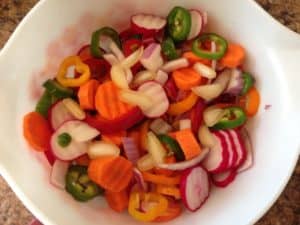 Refrigerator pickles are a great way to use vegetables you have leftover in your fridge, and I don’t just mean cucumbers!
Refrigerator pickles are a great way to use vegetables you have leftover in your fridge, and I don’t just mean cucumbers!
You can pickle almost anything, though some of my favorites are cucumbers, radishes, carrots, peppers, and onions.
You basically just need equal amounts of water and vinegar, a dash of sugar and a dash of salt, and some herbs and spices if you want.
Give it a try, and see what you think!
Freezing Staple Foods
If you have freezer space, freezing fruit, vegetables, meat, and basic items is a great way to stock up some ingredients for later use. Since I do a lot of canning, I don’t freeze as much as some people do. But, though I make and can a lot of jam, we prefer freezing our whole fruit for smoothies.
Freezing Fruit
Freezing fruit is really easy. Depending on the fruit, you can give it a quick soak in lemon juice water to help prevent browning – this is a good idea for apples and peaches especially. But, you just wash your fresh fruit slice it if applicable, and freeze. That’s it!
Some people like to put the fruit out on a parchment-lined baking sheet and freeze it that way before transferring it to freezer bags. This does make sure the fruit doesn’t stick together once it’s in the bag, but I usually skip that step and just lay the bags as flat as I can in the freezer. If the fruit does freeze together a bit, it’s usually really easy to break it apart as long as you don’t fill the bag extra full. A good solid flat layer that fills the whole bag up when closed is what you want to have.
 Another way that we freeze fruit is actually into freezer smoothie packs. So, when we want smoothies for breakfast, we don’t have to drag all of the ingredients out of the refrigerator and freezer – we just grab a smoothie pack and we’re done!
Another way that we freeze fruit is actually into freezer smoothie packs. So, when we want smoothies for breakfast, we don’t have to drag all of the ingredients out of the refrigerator and freezer – we just grab a smoothie pack and we’re done!
Freezing Vegetables
Freezing vegetables can also be really helpful, though I’m a bit more selective about this. The first “rule” is that for MANY vegetables, they need to be blanched before you can freeze them. This helps with both the level of nutrients and quality/texture.
To blanch your vegetables, get a pot of water boiling, drop the vegetables in for however many minutes, and then take them out and put them into an ice bath to stop the process.
Drain fully, and then freeze. If this is something you want to explore for your kitchen, you can read more about blanching times, as the times do vary for different vegetables.
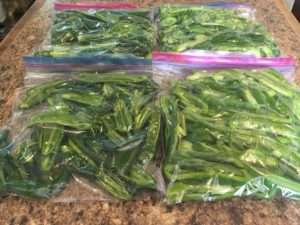 A few things we freeze from our garden are butternut squash, eggplant, corn, Brussels sprouts, cabbage, potatoes, peppers, kale, Swiss chard, and collard greens.
A few things we freeze from our garden are butternut squash, eggplant, corn, Brussels sprouts, cabbage, potatoes, peppers, kale, Swiss chard, and collard greens.
Vegetables I never freeze are green beans, carrots, broccoli, and celery. It isn’t that you can’t freeze them though, and when you do they work okay in soups. I’ve just found the texture of them upon thawing to not be very desirable.
Freezing Staple Foods
Other things you can consider freezing include staple foods that you may not think of normally freezing.
Freezing Eggs
You can actually scramble a bunch of eggs and freeze them in ice cube trays before transferring to a freezer bag for later use, and I’ve also seen some people freeze individual cracked eggs into muffin tins before transferring them to a freezer bag.
I actually haven’t frozen raw eggs personally, I usually make things with them before freezing to give us easy grab-and-go breakfast options. Two things I make regularly in this way are Freezer Breakfast Burritos and Make-Ahead Egg Cups.
Freezing Other Staple Foods
You can also freeze milk, butter, yogurt, and cheese, among lots of other things.
Dehydrating Staple Foods
Dehydrating staple foods is the last thing I want to talk about today. I’ve recently become a huge fan of dehydrating, and after purchasing my Excalibur dehydrator last year, I was putting all kinds of things from the garden in there! It’s really cool because it’s such a space saver. When done correctly, things that you dehydrate can be stored in airtight jars in your pantry, which saves you freezer space. It also shrinks the food in the dehydrating process, so the same amount of food once dehydrated takes up a lot less space than food that is canned via water bath or pressure canning.
Now, don’t see the price on the Excalibur and dismiss the idea of dehydrating. Though I do recommend buying a model with a fan, Nesco makes this one that is more affordable for those who are starting out. Also, you can watch for deals on the Excalibur. I purchased mine for about half price during a sale.
Banana Chips
My absolute favorite thing to dehydrate is banana chips. Think about all the times you see ripe bananas on sale at the store for a dollar or two for a whole bag. Next time, you could buy them and bring them home and make banana chips! They are so much better than the kind you buy at the store.
Mushrooms
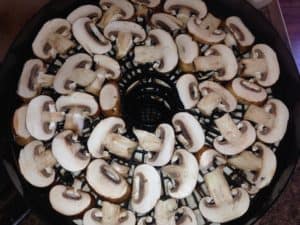 I also love buying mushrooms and slicing and dehydrating them for later use. I live in an area where good mushrooms aren’t always available, so this allows me to stock up when I am somewhere that has them, then come home and dehydrate them for later use.
I also love buying mushrooms and slicing and dehydrating them for later use. I live in an area where good mushrooms aren’t always available, so this allows me to stock up when I am somewhere that has them, then come home and dehydrate them for later use.
Mushrooms are tricky to get completely dry, so I actually do keep these in the freezer after I’m done drying them – but they take up so much less space once they are dehydrated!
Citrus Fruit Slices
Last year, I also dehydrated a bunch of lemon and orange slices, and I’ve been enjoying them in lots of cups of green tea lately. I also dehydrate herbs from our garden, and my dehydrated mint has also been finding its way into my tea.
Herbs & Greens
 I dehydrate lots of herbs from our garden that we use in cooking throughout the year. I also dehydrate a lot of kale and arugula. It’s great to have on hand through the winter months to crumble into pasta dishes, meatballs, soup, the supplemental food I make for our dogs, and more!
I dehydrate lots of herbs from our garden that we use in cooking throughout the year. I also dehydrate a lot of kale and arugula. It’s great to have on hand through the winter months to crumble into pasta dishes, meatballs, soup, the supplemental food I make for our dogs, and more!
What’s Next?
I hope you have found this compilation surrounding staple foods for your family helpful. Throughout my blog, I try to share the message that these things are easy as long as you are willing to try. I didn’t know how to cook or can food until I learned, and you can learn too!
If I can help answer any questions for you, feel free to ask in the comments!
So, what are you going to do first?

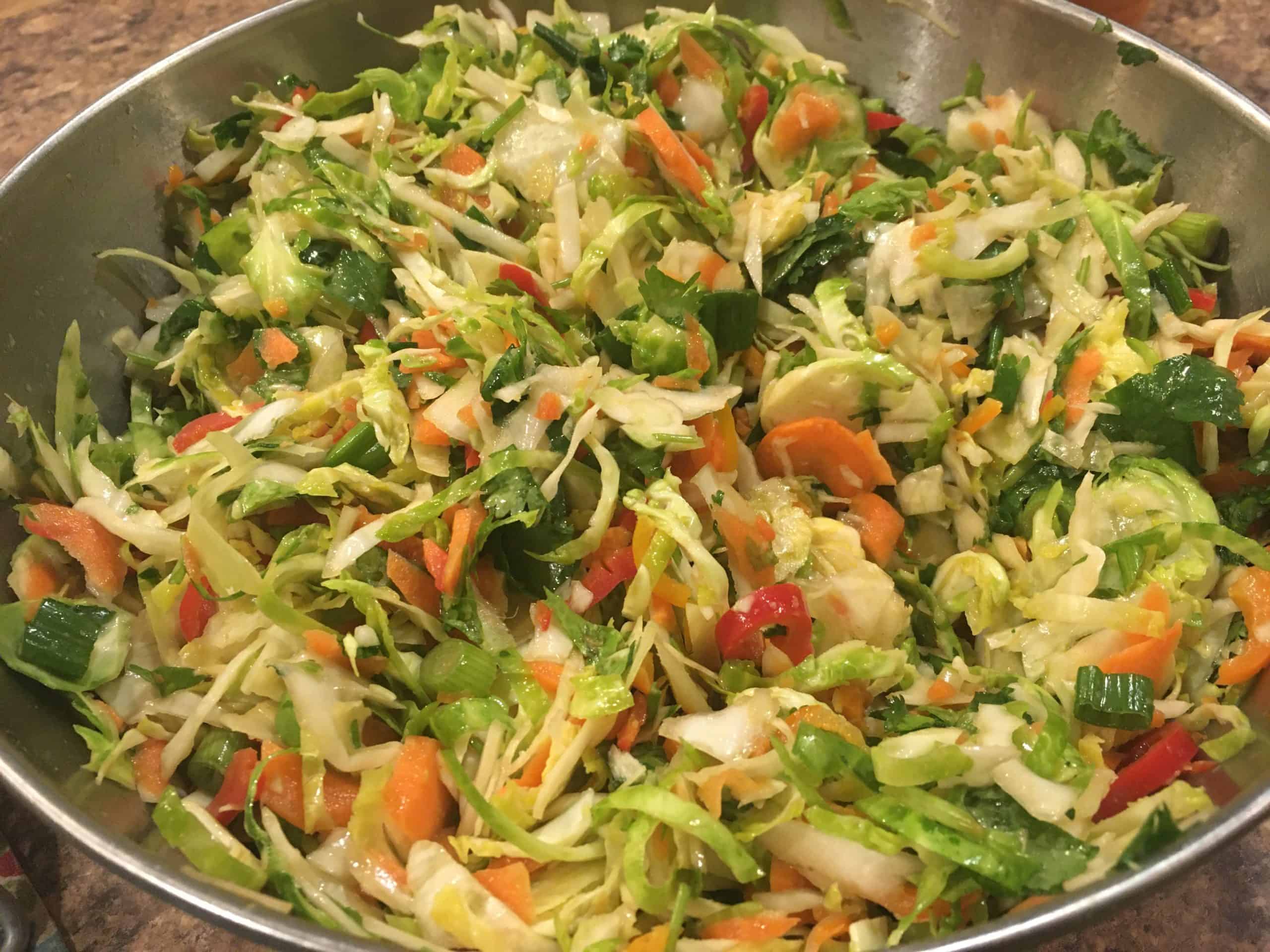
Pingback: How to Maintain a Clean, Green Lifestyle During COVID-19 - Go, Green Mamas!